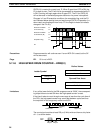
99
Note that in the program just mentioned, the present value in the counter
buffer is transferred to counter number 47 at points A and B. In this case, if
S31 (=1,000) < S < S32 (=2,000) and S33 (=2,000) < S < S34 (=3,000), and
if the present count value of the first high-speed counter (at point A) is 1,999
and that of the second counter (at point B) is 2,003, HR 015 and HR100 may
be simultaneously turned ON. If it is necessary to avoid this, set the values of
S32 and S33 so that there is a value difference equivalent to the time lag
from points A to B. For example, set the value of S32 to 2,000 and that of
S33 to 2,010.
More than 16 output bits may be obtained using CMP.
1813 (normally ON)
1905 (GR)
0600
CMP(20)
CNT 47
#6850
Address Instruction Operands
0000 LD 1813
0001 CMP(20)
CNT 47
# 6850
0002 AND 1905
0003 OUT 0600
In the above program, output 0600 is turned ON when the following condition
is satisfied, where S is the present count value of the high-speed counter:
6,850 < S ≤ 9,999.
1813 (normally ON)
1905 (GR)
1000
CMP(20)
CNT 47
#0300
1813 (normally ON)
1907 (LE)
1001
CMP(20)
CNT 47
#2300
1000 1001
0601
Address Instruction Operands
0000 LD 1813
0001 CMP(20)
CNT 47
# 0300
0002 AND 1905
0003 OUT 1000
0004 LD 1813
0005 CMP(20)
CNT 47
# 2300
0006 AND 1907
0007 OUT 1001
0008 LD 1000
0009 AND 1001
0010 OUT 0601
In the above program, output 0601 is turned ON when the following condition
is satisfied, where S is the present count value of the high-speed counter:
300 < S < 2,300.
The number of digits of the upper and lower limits of the high-speed counter
can be increased from four to eight by using the high-speed counter together
with CNTR and CMP.
Cascade Connection
(Counting Past 9,999)
Timer and Counter Instructions Section 5-11


















